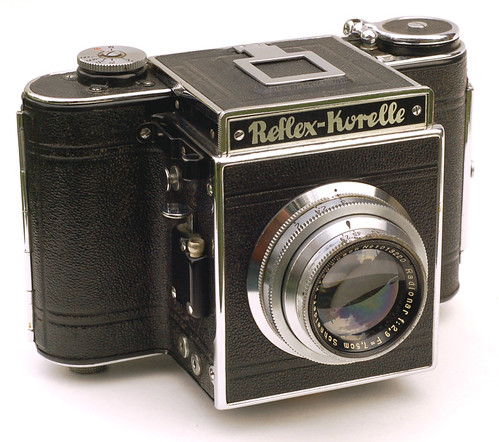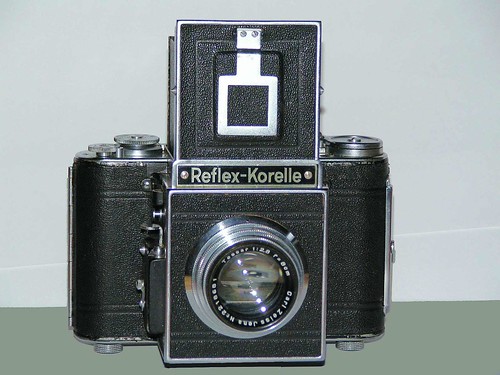Difference between revisions of "Reflex-Korelle"
Rebollo fr (talk | contribs) (reworked: replaced the specs section by a textual description and summary of the evolution) |
Rebollo fr (talk | contribs) (minor details, sources are somewhat conflicting) |
||
| Line 7: | Line 7: | ||
The camera takes 6×6cm exposures on [[120 film]]. It has a [[focal plane shutter]] with horizontally running cloth curtains. There is a fixed waist-level viewfinder on top, with a matte screen and a [[loupe|magnifier]]. The viewing hood has an additional folding frame finder at the top. The camera is focused by turning the lens helicoid. | The camera takes 6×6cm exposures on [[120 film]]. It has a [[focal plane shutter]] with horizontally running cloth curtains. There is a fixed waist-level viewfinder on top, with a matte screen and a [[loupe|magnifier]]. The viewing hood has an additional folding frame finder at the top. The camera is focused by turning the lens helicoid. | ||
| − | == Evolution | + | == Evolution == |
| − | The original '''Reflex-Korelle''' was introduced in 1935, | + | The original '''Reflex-Korelle''' was introduced in 1935. Very early cameras were made with B, 1/10 – 1/1000 speeds, but this was quickly abandoned and that model normally has B, 1/25 – 1/500.<REF> {{MK}}, p.471. The version with 1/25 – 1/500 is called "IA" in Matanle, p.215. </REF> The lens mount is a simple screw thread with 40.5mm diameter.<REF> Matanle, p.215. </REF> |
| − | The '''Reflex-Korelle II''', launched in 1936, differs by the addition of slow speeds (to 2s) and a self-timer. After the introduction of model II, the original model without slow speeds was renamed '''Reflex-Korelle I'''. | + | The '''Reflex-Korelle II''', launched in 1936, differs by the addition of slow speeds (to 2s) and a self-timer.<REF> {{MK}}, p.471. It is called "IIA" in Matanle, p.215. </REF> After the introduction of model II, the original model without slow speeds was renamed '''Reflex-Korelle I'''.<REF> {{MK}}, p.472. </REF> |
| − | + | Some sources say that the two models were modified in 1937 with auto-stop film advance, and renamed '''Ia''' and '''IIa'''.<REF> {{MK}}, p.472. </REF> A simplified '''Reflex-Korelle B''' was sold at the same period, with separate shutter winding and film advance, and with no eye-level finder.<REF> {{MK}}, p.472, Matanle, pp.215–6. </REF> | |
| − | + | A new edition of the '''Reflex-Korelle II''' appeared in 1939 with a chrome finished top plate, replacing the IIa.<REF> {{MK}}, p.472. </REF> The '''Reflex-Korelle III''', released the same year, has chrome plating on the front plate and viewing hood, redesigned controls and speeds from 2s to 1/1000. It introduced a large-diameter bayonet mount, which was also fitted on some examples of the model II.<REF> {{MK}}, p.472. </REF> | |
| − | After World War II, production of the camera was resumed in 1947 by Korelle-Werk, nationalized as VEB WEFO in 1948.<REF> [http://www.retrography.com/kochmann.htm Reflex-Korelle] at retrography.com. </REF> The '''Meister-Korelle''' is a redesigned model, sold in the USA as the '''Master Reflex'''. It has yet another lens mount, with a large diameter screw thread. WEFO was merged into [[Welta]] in 1951, and the production of the camera lasted until 1952. | + | After World War II, production of the camera was resumed in 1947 by Korelle-Werk, nationalized as VEB WEFO in 1948.<REF> [http://www.retrography.com/kochmann.htm Reflex-Korelle] at retrography.com. </REF> The '''Meister-Korelle''' is a redesigned model, sold in the USA as the '''Master Reflex'''. It has yet another lens mount, with a large diameter screw thread. WEFO was merged into [[Welta]] in 1951, and the production of the camera lasted until 1952.<REF> {{MK}}, p.983. </REF> |
== Available lenses == | == Available lenses == | ||
| − | * | + | === Small thread mount === |
| − | * | + | Incomplete list: |
| − | * | + | * [[Carl Zeiss]] Tessar 7.5cm f/2.8 |
| − | * | + | * [[Carl Zeiss]] Tessar 8cm f/2.8 |
| + | * [[Schneider]] Xenar 7.5cm f/2.8 | ||
| + | * [[Schneider]] Radionar 7.5cm f/2.9 | ||
| + | * [[Schneider]] Radionar 7.5cm f/3.5 | ||
| + | * [[Steinheil]] Cassar 8cm f/3.5 | ||
| + | |||
| + | === Bayonet mount === | ||
| + | For the Reflex-Korelle III. | ||
| + | |||
| + | === Large thread mount === | ||
| + | For the Meister-Korelle and Master Reflex: | ||
| + | * [[Meyer]] Primotar 85mm f/3.5 | ||
== Notes == | == Notes == | ||
| Line 28: | Line 39: | ||
== Bibliography == | == Bibliography == | ||
| + | * {{Matanle SLR}} Pp.215–6. | ||
* {{McKeown12}} Pp.471–2 and 983. | * {{McKeown12}} Pp.471–2 and 983. | ||
Revision as of 16:01, 1 June 2009
The Reflex-Korelle was a reflex camera made by Franz Kochmann, later Korelle-Werk, Dresden. It was one of the earliest 6×6cm SLRs. Several camera makers copied it, for example the British company Agilux. Postwar models were named Meister-Korelle or Master Reflex.
Contents
General description
The camera takes 6×6cm exposures on 120 film. It has a focal plane shutter with horizontally running cloth curtains. There is a fixed waist-level viewfinder on top, with a matte screen and a magnifier. The viewing hood has an additional folding frame finder at the top. The camera is focused by turning the lens helicoid.
Evolution
The original Reflex-Korelle was introduced in 1935. Very early cameras were made with B, 1/10 – 1/1000 speeds, but this was quickly abandoned and that model normally has B, 1/25 – 1/500.[1] The lens mount is a simple screw thread with 40.5mm diameter.[2]
The Reflex-Korelle II, launched in 1936, differs by the addition of slow speeds (to 2s) and a self-timer.[3] After the introduction of model II, the original model without slow speeds was renamed Reflex-Korelle I.[4]
Some sources say that the two models were modified in 1937 with auto-stop film advance, and renamed Ia and IIa.[5] A simplified Reflex-Korelle B was sold at the same period, with separate shutter winding and film advance, and with no eye-level finder.[6]
A new edition of the Reflex-Korelle II appeared in 1939 with a chrome finished top plate, replacing the IIa.[7] The Reflex-Korelle III, released the same year, has chrome plating on the front plate and viewing hood, redesigned controls and speeds from 2s to 1/1000. It introduced a large-diameter bayonet mount, which was also fitted on some examples of the model II.[8]
After World War II, production of the camera was resumed in 1947 by Korelle-Werk, nationalized as VEB WEFO in 1948.[9] The Meister-Korelle is a redesigned model, sold in the USA as the Master Reflex. It has yet another lens mount, with a large diameter screw thread. WEFO was merged into Welta in 1951, and the production of the camera lasted until 1952.[10]
Available lenses
Small thread mount
Incomplete list:
- Carl Zeiss Tessar 7.5cm f/2.8
- Carl Zeiss Tessar 8cm f/2.8
- Schneider Xenar 7.5cm f/2.8
- Schneider Radionar 7.5cm f/2.9
- Schneider Radionar 7.5cm f/3.5
- Steinheil Cassar 8cm f/3.5
Bayonet mount
For the Reflex-Korelle III.
Large thread mount
For the Meister-Korelle and Master Reflex:
- Meyer Primotar 85mm f/3.5
Notes
- ↑ McKeown, p.471. The version with 1/25 – 1/500 is called "IA" in Matanle, p.215.
- ↑ Matanle, p.215.
- ↑ McKeown, p.471. It is called "IIA" in Matanle, p.215.
- ↑ McKeown, p.472.
- ↑ McKeown, p.472.
- ↑ McKeown, p.472, Matanle, pp.215–6.
- ↑ McKeown, p.472.
- ↑ McKeown, p.472.
- ↑ Reflex-Korelle at retrography.com.
- ↑ McKeown, p.983.
Bibliography
- Matanle, Ivor. Collecting and Using Classic SLRs. London: Thames & Hudson, 1996. ISBN 0-500-01726-3. Pp.215–6.
- McKeown, James M. and Joan C. McKeown's Price Guide to Antique and Classic Cameras, 12th Edition, 2005-2006. USA, Centennial Photo Service, 2004. ISBN 0-931838-40-1 (hardcover). ISBN 0-931838-41-X (softcover). Pp.471–2 and 983.
Links
In English:
- Reflex-Korelle section on Retrography.com by Simon Simonsen, Denmark
- Reflex-Korelle at Cosmonet's Classic Camera
- Reflex-Korelle at medfmt
- Reflex Korelle leaflet at Marriott World
- Korelle instruction manual @ www.orphancameras.com
In French:
In Italian:

